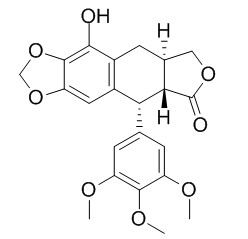(-)-beta-Peltatin
(-)-beta-Peltatin has antimitotic, and antineoplastic activities.
Inquire / Order:
manager@chemfaces.com
Technical Inquiries:
service@chemfaces.com
Tel:
+86-27-84237783
Fax:
+86-27-84254680
Address:
1 Building, No. 83, CheCheng Rd., Wuhan Economic and Technological Development Zone, Wuhan, Hubei 430056, PRC
Providing storage is as stated on the product vial and the vial is kept tightly sealed, the product can be stored for up to
24 months(2-8C).
Wherever possible, you should prepare and use solutions on the same day. However, if you need to make up stock solutions in advance, we recommend that you store the solution as aliquots in tightly sealed vials at -20C. Generally, these will be useable for up to two weeks. Before use, and prior to opening the vial we recommend that you allow your product to equilibrate to room temperature for at least 1 hour.
Need more advice on solubility, usage and handling? Please email to: service@chemfaces.com
The packaging of the product may have turned upside down during transportation, resulting in the natural compounds adhering to the neck or cap of the vial. take the vial out of its packaging and gently shake to let the compounds fall to the bottom of the vial. for liquid products, centrifuge at 200-500 RPM to gather the liquid at the bottom of the vial. try to avoid loss or contamination during handling.
Nat Commun.2021, 12(1):681.
RSC Adv.2018, 32621-32636
Pharmaceutics.2021, 13(2):187.
J Ginseng Res.2023, 47(4):593-603.
Oncotarget.2016, 8(51):88386-88400
J.Pharm. & Biome. Anal.2023, 2: 100018.
J Sci Food Agric.2017, 97(5):1656-1662
J AOAC Int.2024, qsae028.
Sci Rep.2019, 9(1):18080
Anal Biochem.2019, 569:10-15
Related and Featured Products
Pesticide Biochemistry and Physiology, 2002, 72(1):45-54.
Aryltetralin Lignans Inhibit Plant Growth by Affecting the Formation of Mitotic Microtubular Organizing Centers.[Reference:
WebLink]
METHODS AND RESULTS:
The aryltetralin lignans podophyllotoxin, α-peltatin, and β-peltatin((-)-beta-Peltatin
), their respective O-β-d-glucosides, and the semisynthetic derivative etoposide were tested for phytotoxicity. The aglycones were more potent inhibitors than their respective glucosides, and podophyllotoxin was the most active natural lignan tested. These compounds were more active against rye (Lolium multiflorum L.) and onion (Allium cepa L.) than lettuce (Lactuca sativa L.). The semisynthetic lignan etoposide was more active than any of the natural analogues and was phytotoxic to both monocotyledonous and dicotyledonous species. Inhibition of root growth was the main developmental response observed on plants tested with the lignans. At the cellular level, podophyllotoxin and etoposide caused similar symptoms in actively dividing meristematic cells of onion root tips. All phases of mitosis were inhibited by nearly 50%, relative to the controls. Both compounds also induced abnormal star anaphase chromosomal configurations.
CONCLUSIONS:
While the precise molecular mechanism of action of these compounds remains to be identified in plants, a primary effect is the alteration of the formation of the spindle microtubular organization centers, resulting in the formation of multiple spindle poles and an asymmetrical convergence of the chromosomes.



